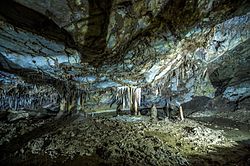Marble Cave, Kosovo
| Marble Cave | |
|---|---|
| Shpella e Mermerit / Gadimes (Albanian) | |
 | |
| Location | Gadime e Ulët, Kosovo |
| Coordinates | 42°28′48″N 21°12′20″E / 42.48006°N 21.205538°E |
| Discovery | 1966 |
| Geology | Karst limestone |
The Marble Cave or the Gadime Cave (Albanian: Shpella e Mermerit; Serbian: Мермерна пећина/Mermerna pećina) is a karstic limestone cave in the village of Gadime e Ulët in the municipality of Lipjan in Kosovo.[1][2] Much of it is still unexplored. The cave was found in 1966 by a villager, Ahmet Asllani, who was working on his garden.[3][4]
Overview[edit]
Gadime Cave is located within the marble limestones belonging to the Mesozoic era.[1] The cave was formed during the tertiary period.[5] In course of time the marble was subjected to cracking as a result of tectonic erosions.[1]
The entrance to the cave is in two directions. The lower direction is relatively complicated and consists of 3 transverse channels, 2 parallel and curved corridors. The upper direction consists of two combined corridors. The total length of the cave is 1.260 m and its area is 56.25 ha.[1]
Gallery[edit]
See also[edit]
References[edit]
- ^ a b c d "HUMAN IMPACTS IN A TOURIST KARSTIC GADIME CAVE (KOSOVA)" (PDF).
- ^ Bajraktari, Fadil (2012). "PROTECTION OF KARST CAVES IN KOSOVO". ResearchGate.
- ^ Schuman, Michael (14 May 2014). Serbia and Montenegro Nations in Transition. Infobase Publishing. p. 137. ISBN 9781438122526. Retrieved 27 February 2016.
- ^ Gadime Cave (Gadime e Ulët), Kosovo. National Geographic: Western Balkans Geotourism Map Guide. Archived 24 January 2014.
- ^ Mustafa, Behxhet; Hajdari, Avni; Mustafa, Valmir; Pulaj, Bledar (2018). "Natural Heritage in the Republic of Kosovo: Looking for Potential UNESCO Sites" (PDF). Landscape Online. 63: 1–16. doi:10.3097/LO.201863.
Further reading[edit]
- 501 Must-visit Natural Wonders. Bounty Books. 2007. ISBN 978-0-7537-1591-8.
- "Mermerna pećina" (in Serbian). Archived from the original on 23 December 2003. Retrieved 18 February 2009.





